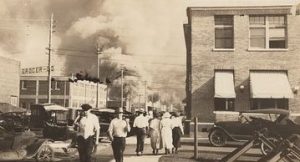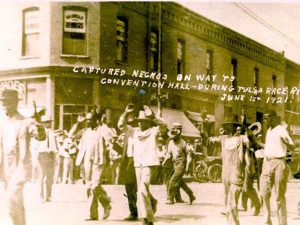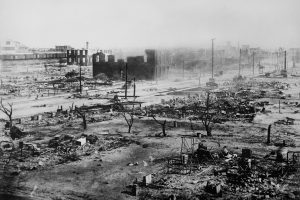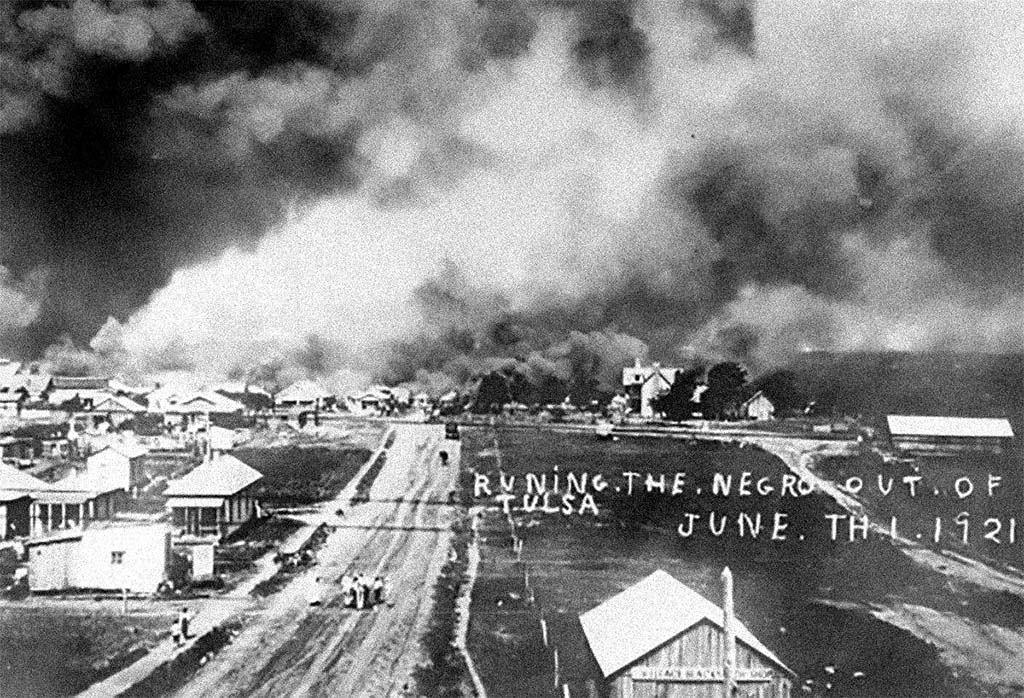In the article that follows Syracuse University historian Herbert G. Ruffin II takes us back in time to describe the Tulsa Race Massacre of 1921 on the eve of its 100-year anniversary.
African American life and the passing down of wealth from one generation to the next in the United States has always been frail and never guaranteed. Blacks’ expectations of equality can be meet in one instance and instantly lost in the next. This was the lesson that many learned during the red-hot summers from 1917 to 1923. This was a period which experienced twenty-three race riots and massacres, with the worst case of white supremacist terrorism occurring in Tulsa, Oklahoma between May 31 and June 1, 1921.
Tulsa was an early 20th Century boom town that transformed overnight from a sleepy rural community to a major metropolis. Catapulted by the major discovery of oil at nearly Glenn Pool in 1905, Tulsa’s population exploded from 10,000 people in 1910 to over 100,000 in 1920. Along with this growth came the rapid establishment of railroads, interurban trains lines, daily newspapers, telegraph companies, banks, a commercial airport, and infrastructure built for newly developed automobile. This Tulsa was a white-dominated setting that blacks may have worked in as domestics and in manual labor jobs connected with the oil industry and its secondary occupations, but it was not one structured to allow them to enjoy the fruits of their labor. For this they established an alternative, their own promised land north of the Frisco railroad yards in a place called Greenwood.
Greenwood was “bordered by the Frisco railroad yards to the south, by Lansing Street and the Midland Valley tracks to the east,…by Standpipe and Sunset Hills to the west” and past Pine Street or “The Section Line” to open country in the north. The heart of this community was its people, 95% of whom lived modest lives compared to their white counterparts in poorly built frame houses often without electricity, indoor plumbing, and paved streets. The spine of the community was the commercial district at the intersection of Archer and Greenwood called Deep Greenwood, better known to the world as “Black Wall Street.” This district was anchored by the black-owned Gurley and Stradford hotels. In 1921, on the eve of the Massacre, Greenwood had 108 black businesses including barbershops, billiard halls, churches, clothing stores, fraternal lodges, funeral parlors, a hospital, hotels, markets, movie theaters, newspapers, nightclubs, a public library, public schools, and restaurants. Its professional and skilled classes included attorneys, physicians, ministers, tailors, hairdressers, and shoemakers. Black Wall Street epitomized the best that could be achieved in a racially segregated society, a large degree of African American control over its major institutions, a self-contained black city within a larger and hostile white one.
As impressive this situation was, it was important to note that Tulsa was a troubled city in which white Tulsans purposely ignored or denigrated the African American community. Guided by racial stereotypes, deep-rooted prejudices, and mass layoffs in the oilfields, it was not a surprise that rumor, and insinuation created fertile ground for race paranoia and the rapid growth of white supremacist terrorist hate groups like the Ku Klux Klan. In the 1920s the Oklahoma Klan included farmers, ranchers, miners, oil field workers, small town merchants, big city businessmen, ministers, newspaper editors, policemen, educators, lawyers, judges, and politicians, a cross-section of the entire white population. This combustible mix and the increase of lynching and mob violence placed Tulsa on the path of self-destruction.
The event which caused black leaders to seriously consider their precarious situation was the lynching of Roy Belton. In August 1920, Belton, who was white, was arrested for hijacking and shooting local cab driver Homer Nida. Before this case came to trial, a white mob stormed the courthouse, captured Belton, took him to the countryside area where Nida was murdered, and lynched him.
News of this lynching had Black Tulsans like businessmen A.J. Smitherman wonder: “What about the next time that an African American was charged with a serious crime in Tulsa, particularly if it involved a white victim? What would happen then?” Determined that no black person ever fall victim to mob violence, Smitherman and other local African American leaders recommended that Black Tulsans, from World War I veterans to businessmen to common laborers, all consider using armed resistance as a self-defense tactic.
The local fires of discord were further inflamed within white Tulsa on August 20, 1920, when the highly volatile subject of black men intermingling with white women make the front pages. This was coded in language about the need to end prostitution and “kick out the Negro pimps if we want to stop this vice.” Another newspaper report focused on whites slumming in Greenwood and singing and dancing with black people, with special attention given to the fun that young white women were having. Five days later, a series of spectacular jailbreaks happened. Then in the morning of May 30, 1921 (Memorial Day), the unimaginable occurred: a white woman was allegedly assaulted by a black man.
According to the Tulsa Race Commission Report (2001) 19-year-old bootblack Dick Rowland probably “tripped as he got onto a elevator and, as he tried to catch his fall, he grabbed onto the arm of [elevator operator] 17-year-old Sarah Page, who then screamed.” Both 19-year-old Rowland and 17-year-old Page worked in the Drexel building. Because of race restrictions the only bathroom that blacks could use was on the top floor of the building. The only way to get to that bathroom was though an elevator manually handled by an operator like Page. A clerk at Renberg’s clothing store in the building heard a scream and called police.
The alleged assault was recorded as an attempted rape. Yet Page’s testimony does not exist in police reports. A day later, a terrified Rowland was arrested at his adopted mother’s home and taken to the courthouse to be held for trial. Under new police sheriff Willard M. McCullough, the investigators initially took a deliberate approach to investigating this case without the gaze of the media. However, between lawyers and newspapers like the Tulsa Tribune, by 7:34 p.m. on May 31, innuendo and rumor quickly spread, alarming and mobilizing white supremacist terrorists into action. Initially, several hundred whites surrounded the courthouse with the intent to lynch Rowland. But new sheriff was not having it, barricading himself and twenty-five police officers on the top floor of the three-story courthouse.

Rioters Leaving Black Wall Street
Meanwhile, in Greenwood, black residents met and came to three conclusions: arm themselves and save Rowland from the mob; pray; or flee to the North. In two waves at 9:00 p.m. and 10:00 p.m., around 100 armed blacks came to the courthouse to aid the sheriff. He turned them away both times, indicating that everything was under control. More important, the sight of former black military vets in uniform and blacks carrying arms and breaking Tulsa’s race etiquette, enraged the white mob of around 2,000 who had gathered near the courthouse. They prepared for a race war. Those whites who did not already have a gun and ammunition raided downtown sporting goods stores, hardware stores, and pawnshops. With shouts of “bring the rope” and “get the n-word,” the mob’s goal now expanded from lynching Rowland to murdering the armed African Americans who crossed the Frisco railroad tracks and dared interrupted their courthouse invasion.

Captured Blacks on Way to Jail
At 10:14 p.m. Oklahoma state officials got word of the impending riot in Tulsa. Yet it would be four hours, around 2:15 a.m. before Governor James B.A. Robertson authorized state troops to go to the city. Meanwhile Rowland’s champions fought with the mob to get back to Greenwood. Teachers and ministers prayed and hoped for the violence to pass. About forty blacks did not wait and fled to the Northeast countryside. They were the fortunate ones. At 11 p.m., Tulsa’s all-white National Guard was mobilized for “riot control” with the intent of putting down what they interpreted as a black uprising. They stopped and arrested all adult male black Tulsans, processing them at Conventional Hall and then placing them under their “protection” in make-shift internment camps. The 75-man Tulsa police force “deputized” mob members ranging from 10 years old to adult, authorizing them to imprison blacks and occupy Greenwood. Between midnight and 1:30 a.m. on June 1, the first fires were set to burn Greenwood. Nonetheless most of the anti-black violence seemed to be slowing down prompting many local blacks to believe by 2:00 a.m. that their nightmare had ended. Little did they know that the setback of darkness only made the mob angrier.
Stoked by false rumors, meetings were taking place throughout the night all over white Tulsa. These rumors included claims of five hundred armed blacks coming to Tulsa by train from Muskogee to assist the uprising, or large bands of blacks firing on white residents and in the process, killing a white woman. Incensed, the mob decided to invade Greenwood at sunrise. This massacre proceeded with military-like precision. At 5:00 a.m. on June 1, an unusual whistle/ siren sounded, setting off three clusters of now thousands of whites who invaded Greenwood from three strategic railroad passenger stations near the edge of the community, and for the first time in U.S. history, by plane. For good a period of the morning African Americans such as John Wesley Williams and Peg Leg Taylor were able to fight off this onslaught from areas like Sunset Hill and the newly built Mount Zion Baptist Church. But they were ultimately surrounded, smoked out, and pummeled into dropping their arms. As for blacks who decided to flee north, most were tracked down by planes and contained by gunfire and dynamite.
Some blacks were able to survive when sympathetic whites and Mexican immigrants opened their homes to them. Others hid when and where they could. Five-year old George Monroe and his older siblings survived after sister Lottie prevented him from crying by covering his mouth while mob members searched their home. Other black residents, imprisoned by mob members, were terrorized by being forced to dance while white rioters shot at the heels of their feet. In one instance a black resident was dragged around town by automobile with a noose around his neck. In one of the most heinous acts of wanton violence, mob members tracked down the nationally famous black surgeon, Dr. A.C. Jackson. After surrendering to mob members who promised he would be protected, the surgeon was murdered in cold blood. While death figures will never be completely determined with accuracy, at least 300 black people died in this eighteen-hour effort to destroy an American community of upstanding, hardworking people. Hundreds more were injured, and more than 1,000 black-owned homes and businesses were destroyed. The Massacre ended by noon on June 1 when Governor Robertson placed the city under martial law. By this point he had sent 109 white state troopers to control the violence even though they had been present in the city since 7:30 a.m.
The “Tulsa Riot” made front page news across the United States. Meeting on June 25, 1921, the Tulsa County Grand Jury blamed the Blacks for inciting the riot. Their report stated that “The assembly was quiet until the arrival of armed Negroes, which precipitated and was the direct cause of the entire affair.” As for the white supremacist terrorism the report added that “There was no mob spirit among the whites, no talk of lynching and no arms.”
In the Massacre’s aftermath, most Black Tulsans were homeless and penniless. They stayed and rebuilt Greenwood from its ashes. The only Black homes spared were in the countryside on the eastern and northern edge of Greenwood where they were interspersed with white homes. This was also the area where Blacks had the greatest success in finding sympathetic whites who provided their homes as safe houses for Massacre survivors.
In the first year after the Massacre most Black Tulsans lived in tents and were assisted by the Red Cross, synthetic whites, and financial support from throughout the nation. By 1922 most of the temporary tents were replaced with new homes. Crucial in that development was the role of the black law firm, Spears, Franklin & Chappelle, which managed to overturn a city fire ordinance that would have made reconstruction in the neighborhood prohibitively expensive. Buck Colbert Franklin, the father of historian John Hope Franklin, was a partner in the firm and a leader in the effort to rebuild Black Tulsa.
Yet, there was hardly any restitution for the loss of life or property. While most African Americans were separated from family members in internment camps, 120 mass graves were dug. The largest unmarked graves were at Booker T. Washington Cemetery, Newblock Park, Oaklawn Cemetery, and along Sand Springs road. Efforts are ongoing today to uncover more of these graves. Additionally, insurance companies were allowed to drag out claims for years. Conversely, the Klan easily manipulated Oklahoma’s racial climate after the Massacre to have its membership surge to over 100,000 by 1925. The Massacre’s history was essentially erased from history books and public memory until Ed Wheeler published “Profile of a Race Riot” in Impact Magazine (1971) months after Massacre survivors publicly addressed their traumas for the first time at historic Booker T. Washington High School.
In 1995, the State of Oklahoma publicly acknowledged and apologized for the Massacre as civic and political figures began a campaign to get restitution for Massacre survivors. Ironically, these efforts went viral after other citizens demanded that the state memorialize and never forget the April 19, 1995 domestic terrorist bombing of the Alfred P. Murrah Federal Building in downtown Oklahoma City. The Oklahoma legislature responded by authorizing the formation of the Oklahoma Commission to Study the Tulsa Race Riot of 1921 in preparation for its eightieth-year anniversary and the state’s one-hundredth year anniversary (2007). As historians John Hope Franklin and Scott Ellsworth wrote in the Commission’s final report (2001), “we can best honor that past not by burying it, but by facing it squarely, honestly, and, above all, openly.” Echoing many of President Bill Clinton’s “Advisory Board to the President’s Initiative on Race” (1997-98) which Franklin also chaired, the Tulsa Race Riot report concluded that the city had colluded with the white mob against its African American citizens. For this they recommended restitution for African American survivors and their descendants; a scholarship fund for descendants; economic development in the Greenwood district; and a memorial for the victims.
So far in 2021, Massacre survivors have received a gold medal from the of Oklahoma and an apology, however, few have received substantial restitution for themselves or their descendants. The college scholarship fund has supported approximately 300 descendants; the Greenwood commercial district has been rebuilt as a historical district; and the heart of Black Tulsa, which is its people, has been memorialized through the 2018 opening of John Hope Franklin Reconciliation Park. Only time will tell, however, if the lessons of the Tulsa Massacre have been permanently learned so that the community can say with confidence, never again, and the victims of the Tulsa Massacre can finally rest in peace.

Carnage from the Tulsa Race Riot
Lorem ipsum dolor sit amet, consectetur adipiscing elit, sed do eiusmod tempor incididunt ut labore et dolore magna aliqua. Ut enim ad minim veniam, quis nostrud exercitation ullamco laboris nisi ut aliquip ex ea commodo consequat. Duis aute irure dolor in reprehenderit in voluptate velit esse cillum dolore eu fugiat nulla pariatur. Excepteur sint occaecat cupidatat non proident, sunt in culpa qui officia deserunt mollit anim id est laborum.


